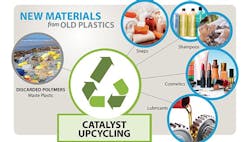Catalyst Promises To Ease Plastic Recycling
Plastics recycling continues to draw the attention of researchers and industrial firms working to tackle the growing global pollution crisis in single-use plastics (see, “Industry Breaks the Mold for Discarded Plastics” and “How Industry Tackles Plastics Plague”).
Now, the U.S. Department of Energy’s Ames Laboratory, Ames, Iowa, has developed a novel catalyst that converts polyolefin plastics, such as polyethylene and polypropylene — commonly found in everyday plastic items such as grocery bags and food containers — into high-quality components suitable for producing high-value products such as fuels, solvents and lubricating oils. It could potentially turn these and other used plastics into an untapped resource, believe the researchers.
Scientist Wenyu Huang of Ames Laboratory designed a mesoporous silica nanoparticle consisting of a core of platinum with catalytic active sites. Long polymer chains thread through the catalyst via silica pores that surround the site. With this design, the catalyst is able to grasp and cleave the longer polymer chains into shorter pieces that have the most potential to be upcycled into new, more-useful end products. An article in Nature Catalysis contains more detail.
“This type of controlled catalysis process has never before been designed based on inorganic materials,” notes Huang, who specializes in the design of structurally well-defined nano-catalysts. “We were able to show that the catalytic process is capable of performing multiple identical deconstruction steps on the same molecule before releasing it.”
Furthermore, this controllability could lead to design systems that exclude certain large nonlinear molecules, as well as optimize the center point of the product distribution.
“The narrow pore in mesoporous silica could slow down or prevent the diffusion of large nonlinear molecules in the pore, and thus the access of polymers to the active sites located at the end of the pore. This will increase the reactant selectivity and, ultimately, the product selectivity,” explains Huang. “… However, this will require much more research to achieve a better understanding of the molecular-level reaction mechanism.”
The researchers have recycled the catalysts for several cycles, suggesting the catalysts are quite robust. The special confined structure of the active Pt nanoparticles inside the mesoporous silica shell strengthens the catalyst, says Huang.
Furthermore, their susceptibility to poisoning would be the same as Pt catalysts already in use. “We would note that the catalyst remains active even in the presence of impurities in post-consumer polyethylene films, used in grocery bags,” adds Aaron Sadow, a scientist at Ames Laboratory and director of the Institute for Cooperative Upcycling of Plastics (iCOUP).
The researchers foresee this catalyst being able to handle a mixed stream of polymers of different structures, such as polyethylene and polypropylene that form the bottle and cap of plastic milk containers.
“The design of catalytic materials could allow conversions [of] mixtures of two or more plastics by using larger diameter pores, or it could convert one kind of chain in the mixture, using the pore to exclude bigger chains,” reckons Sadow.
“We could design nanoparticles targeting different polymers and use sequential processes to achieve the conversion of mixed polymers,” suggests Huang.
Producing the nanoparticles with active sites on a larger scale does pose some issues, namely, developing new synthesis processes to achieve large-scale production of the structured catalysts. “We are currently developing flow processes for polymer upcycling,” says Huang.
iCOUP, a DOE Energy Frontier Research Center consisting of several universities and led by Ames Laboratory, will expand and continue the research. To learn more about its work, visit http://bit.ly/2WrZZZb.
The team has a provisional patent on the catalyst and processive process and is exploring commercial collaborations.
